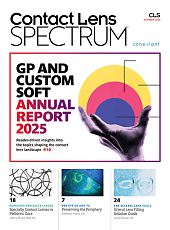Reframing the conversation around photochromic lenses begins with self-reflection. Too often, personal bias or outdated assumptions get in the way, especially when an optician hasn’t experienced the benefits firsthand. That’s why it’s essential for everyone in the practice who makes lens recommendations to wear a modern photochromic lens themselves, transforming recommendations from abstract to authentic.

Once the practice is on board, set a standard: Position photochromic features alongside antireflective and scratch-resistant coatings as a baseline enhancement to all lenses.
Lifestyle Framing
Asking lifestyle-focused questions is one of the most effective ways to uncover a patient’s true visual needs. It encourages them to share details about their lifestyle that they might not have considered relevant and allows you to offer photochromics as a solution to a problem they may not even realize exists.
“What does an average day look like for you?” Daily tasks are where photochromic lenses really shine. UV protection is one less thing to think about when patients are walking the dog, getting groceries, or dropping their kids off at the bus stop. As the lenses automatically adapt to the amount of UV, the wearer often doesn’t even notice the change; they just experience comfortable clarity of vision.
“Do you switch between sunglasses and clear lenses?” Only a small percentage of prescription eyeglass wearers have a pair of Rx sunglasses. Photochromic lenses can be a solution to patients’ cost concerns and reluctance to carry multiple frames. Plus, they can be an introduction to the joys of prescription sunwear—potentially leading to an Rx sunwear purchase in the future.
Inclusive Phrasing
✘ “Would you like to add…?” This supports the perception that photochromics are an unnecessary add-on.
✘ “Do you want those lenses that change color?” This makes it easy for patients to decline rather than ask for more information. ECPs should always lead with education about lens options—a key value of an in-person buying experience.
✔ “For your everyday pair, I recommend…” This sets up your authority and expertise as the ECP making a recommendation for the health of your patient’s eyes. When presented with a tailored lens recommendation, a patient can be twice as likely to follow through with the purchase.
✔ “What I like most about my adaptive lenses is…” Share a personal example that underlines the benefits you’ve already explained to the patient.
Address Misconceptions
When you feel confident tackling misinformation directly, you shift the conversation from hesitation to trust.
• “They don’t get dark enough.” Tell them about the different technologies, like polarized or extra-dark options.
• “They take too long to change.” Explain that current photochromic lens technology shifts within seconds.
• “They don’t work in my car.” Pre- sent specialized driving options that ensure activation behind the windshield.
• “They’re too expensive.” Reframe their purchase as a two-in-one solution—an upgrade that is a fraction of the cost of a separate pair of prescription sunglasses.
• “Those aren’t very stylish.” Photochromics now come in more than a dozen colors across different lens manufacturers, elevating them from a functional feature to a style-forward enhancement.
Presentation Techniques
Give patients the opportunity to experience photochromic lenses—how fast they shift, what they look like, and how the many color options can pair with frames. Set up a demonstration area somewhere accessible to invite interactive play with samples and a UV light for activation.
Presenting photochromic lenses as an everyday solution rather than an optional upgrade shifts the conversation from price and hesitation to protection, convenience, and style. With clear communication and the ECP’s confidence in the product, patients see photochromics in a new light and a natural choice for their new eyewear.



